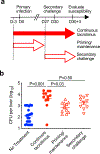Tacrolimus exposure windows responsible for Listeria monocytogenes infection susceptibility
- PMID: 34057792
- PMCID: PMC8455418
- DOI: 10.1111/tid.13655
Tacrolimus exposure windows responsible for Listeria monocytogenes infection susceptibility
Abstract
Tacrolimus is widely used to prevent graft rejection after allogeneic transplantation by suppressing T cells in a non-antigen-specific fashion. Global T-cell suppression makes transplant recipients more susceptible to infection, especially infection by opportunistic intracellular pathogens. Infection followed by secondary challenge with the opportunistic intracellular bacterial pathogen, Listeria monocytogenes, was used to probe when tacrolimus most significantly impacts antimicrobial host defense. Tacrolimus-treated mice showed no difference in innate susceptibility following primary infection, whereas susceptibility to secondary challenge was significantly increased. Modifying the timing of tacrolimus initiation with respect to primary infection compared with secondary challenge showed significantly reduced susceptibility in tacrolimus-treated mice where tacrolimus was discontinued prior to secondary challenge. Thus, tacrolimus overrides protection against secondary infection primed by primary infection (and presumably live attenuated vaccines), with the most critical window for tacrolimus-induced infection susceptibility being exposure immediately prior to secondary challenge. These results have important implications for strategies designed to boost antimicrobial T-cell-mediated immunity in transplant recipients.
Keywords: T cell; adaptive immunity; immune suppression; intracellular bacteria; opportunistic infection.
© 2021 Wiley Periodicals LLC.
Conflict of interest statement
DECLARATION OF INTERESTS
The authors declare no conflicts interests.
Figures



Similar articles
-
Failure of FK 506 to suppress the T cell-mediated immunity of mice to Listeria monocytogenes.Clin Exp Immunol. 1993 Jun;92(3):473-6. doi: 10.1111/j.1365-2249.1993.tb03423.x. Clin Exp Immunol. 1993. PMID: 7685672 Free PMC article.
-
Cytotoxic T-lymphocyte antigen 4 blockade augments the T-cell response primed by attenuated Listeria monocytogenes resulting in more rapid clearance of virulent bacterial challenge.Immunology. 2009 Sep;128(1 Suppl):e471-8. doi: 10.1111/j.1365-2567.2008.03001.x. Epub 2008 Dec 17. Immunology. 2009. PMID: 19191906 Free PMC article.
-
Increased dendritic cell numbers impair protective immunity to intracellular bacteria despite augmenting antigen-specific CD8+ T lymphocyte responses.J Immunol. 2004 Mar 15;172(6):3725-35. doi: 10.4049/jimmunol.172.6.3725. J Immunol. 2004. PMID: 15004177
-
Alteration of non-specific resistance to infection with Listeria monocytogenes.Infection. 1988;16 Suppl 2:S112-7. doi: 10.1007/BF01639732. Infection. 1988. PMID: 3138182 Review.
-
Why is Listeria monocytogenes such a potent inducer of CD8+ T-cells?Cell Microbiol. 2020 Apr;22(4):e13175. doi: 10.1111/cmi.13175. Cell Microbiol. 2020. PMID: 32185899 Free PMC article. Review.
Cited by
-
Tacrolimus Pharmacotherapy: Infectious Complications and Toxicity in Organ Transplant Recipients; An Updated Review.Curr Drug Res Rev. 2025;17(2):301-310. doi: 10.2174/0125899775259326231212073240. Curr Drug Res Rev. 2025. PMID: 38151846 Review.
-
Immune suppression sustained allograft acceptance requires PD1 inhibition of CD8+ T cells.J Immunol. 2025 Jan 1;214(1):192-198. doi: 10.1093/jimmun/vkae007. J Immunol. 2025. PMID: 40073258
References
MeSH terms
Substances
Grants and funding
LinkOut - more resources
Full Text Sources
Other Literature Sources
Medical

